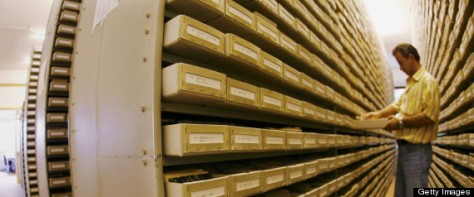Rivaled only by Israel’s Yad Vashem Holocaust Center and the Washington Holocaust Memorial Museum in historical value, Bad Arolsen contains 30 million documents on survivors of Nazi camps, Gestapo prisons, forced laborers and displace persons. One example of the power of preserving the past is George Jaunzemis who received a letter in 2010 from the International Tracing Service in Bad Arsolen which changed his life finding out his real name was Peter Thomas and had a nephew as well as a cousin in Germany. He never knew that the Latvian women he emigrated with to New Zealand was not his mother and had no memory of his early years as he was only three and half at the end of WWII when he separated from his mother as she fled with him from Germany to Belgium. Jaunzemis, 71, told Reuters, “I was astonished, thrilled. After all this time, I was an uncle. You don’t know what it’s like to have no family or childhood knowledge. Suddenly all the pieces fitted, now I can find my peace as a person.” Even though the story has a seemingly happy ending, it took Jaunzemis three decades of searching to find the vast archive in a remote corner of Germany.
Many people don’t even know the archive exists as it was only opened to researchers in 2007 after being widely criticized for overprotecting the original material locked in its facility, but Bad Arolsen still struggles to receive the recognition it deserves says many academics. Only 2,097 people visited Bad Arolsen compared to 900,000 who visited Yad Vashem reports Reuters. Rebecca Boehling, a historian from the Dresher Center for Humanities at the University of Maryland in Baltimore County, wants to change this, “We have a new agenda. We’re sitting on a treasure trove of documents. We want people to know what we have. Our material can change our perspective on big topics related to the war and the Holocaust.” Boehling is the first archive director not affiliated with the International Committee of the Red Cross who managed Bad Arolsen since 1955 who handed the reins over to an international commission of 11 countries in January hoping to open the archives for academic study. Boehling hopes to open the archive for international conferences, get foreign students to use the ITS, publish research and host teachers’ workshops even though the budget of 14 million euros from the German government may not cover it all. The archive, as Boehling believes should be used as an educational tool for the younger generations as the ITS can provide an abundance of personal stories from victims and hope the events they host will draw more than just the townspeople and groups of pupils from nearby.
The location of the archive site in Bad Arolsen was chosen because of its central location between Germany’s four occupation zones and located next to a site where Hitler’s SS officers once had barracks according to Reuters. The problem now is there are no big cities nearby and connections to Berlin and Frankfurt are slow as the town itself is location on the norther edge of the state of Hesse population of just 16,000. The archive itself hold clues to the fate of 17.5 million people housed in a white building that included 25 kilometers of yellowing paper showing typed lists of Jews, homosexuals and other persecuted groups, files on children born to the Nazi Lebensborn program to breed the master race and registers of arrivals as well departures from concentration camps. A carbon copy of Schindler’s List is even housed here with the 1,000 Jewish workers saved by German industrialist Oskar Schindler. As spokeswoman, Kathrin Flor explains, “At death camps like Sobibor or Auschwitz, only natural causes of death are recorded – heart failure or pneumonia. There’s no mention of gassing. The last evidence of many lives is the transport to the camp.”
The ITS receives 12,000 inquiries a month to and reunites 50 families a year as the number of Holocaust survivors decrease the work continues as the new phenomenon of grandchildren and great grandchildren want to find out about the fate of their loved ones during the war. The task of digitalizing the records is an ongoing project in order to make the archive user friendly and easier to search the large database. Even though the location is remote, Boehling says the archive will not be moved as it has become a memorial to the Holocaust survivors like Auschwitz inmate Thomas Buergenthal who came in 2012 after getting new information on where his father perished Reuters reports. He himself escaped Nazi shooting squads, Auschwitz gas chambers and a death march before the age of 12 later he was found by his mother found him in a Polish orphanage in 1947 through the Red Cross. As he explains from his home in the U.S. at 78, “This is my hallowed ground. These documents are more important for the future than for the past. They will be the common heritage of mankind of what really happened during that period. (They are) what we need to prevent it happening elsewhere in the world.”



Excellent weblog right here! Additionally your site rather a lot up very fast!
What host are you the use of? Can I get your associate hyperlink on your host?
I want my website loaded up as quickly as yours lol
LikeLike
Hello there, just became aware of your blog through Google, and found that it’s truly informative.
I’m going to watch out for brussels. I’ll be grateful if you continue this in future.
A lot of people will be benefited from your writing.
Cheers!
LikeLike
Hi, I ddo believe this is an excellent website.
I stumbledupon it 😉 I will come back once again sinbce
I bookmarked it. Money and freedom is the greatest way tto change, may you be rich and continue too help other people.
LikeLike
Great delivery. Great arguments. Keep up the good work.
LikeLike